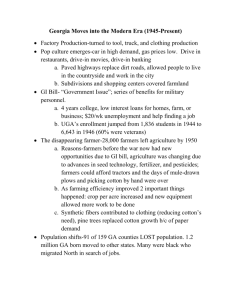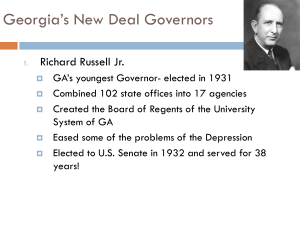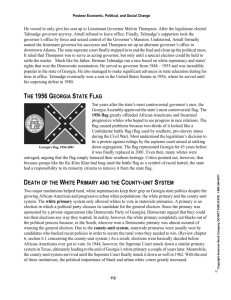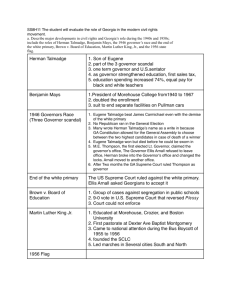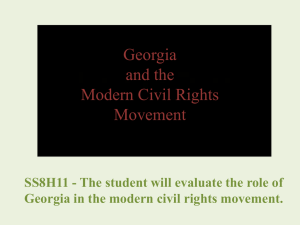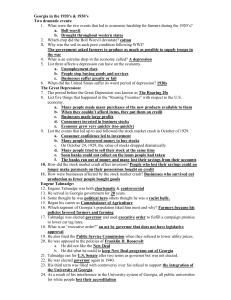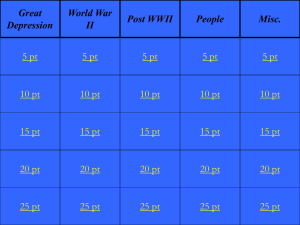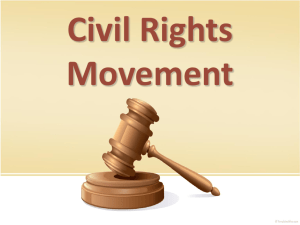File - AMMS Georgia Studies
advertisement
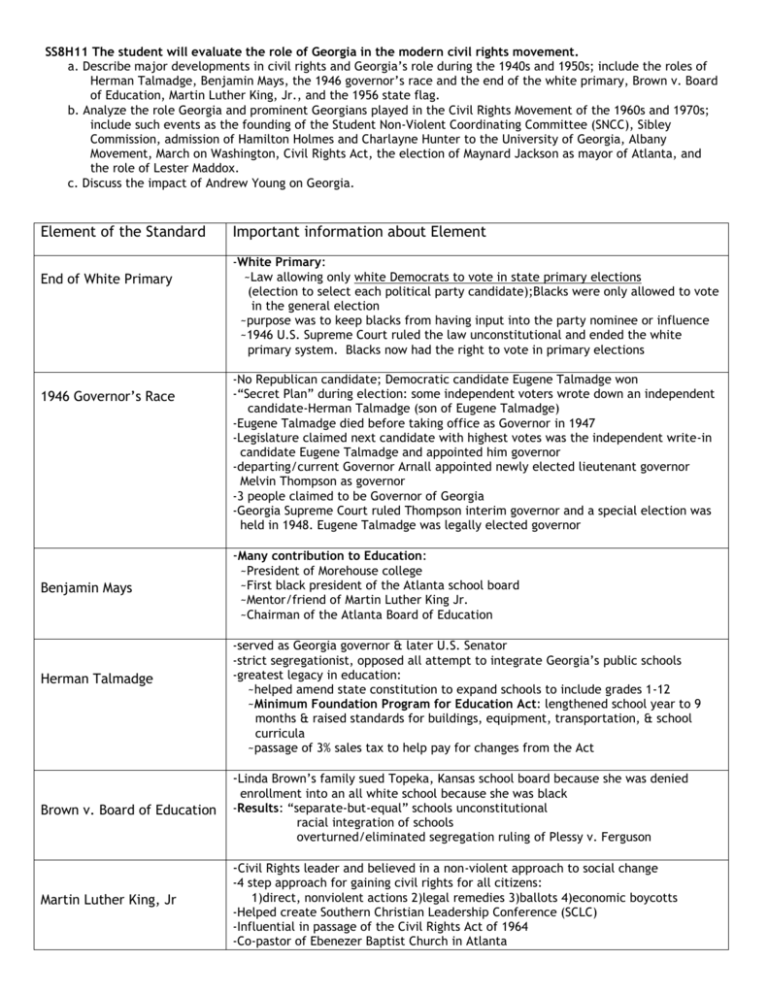
SS8H11 The student will evaluate the role of Georgia in the modern civil rights movement. a. Describe major developments in civil rights and Georgia’s role during the 1940s and 1950s; include the roles of Herman Talmadge, Benjamin Mays, the 1946 governor’s race and the end of the white primary, Brown v. Board of Education, Martin Luther King, Jr., and the 1956 state flag. b. Analyze the role Georgia and prominent Georgians played in the Civil Rights Movement of the 1960s and 1970s; include such events as the founding of the Student Non-Violent Coordinating Committee (SNCC), Sibley Commission, admission of Hamilton Holmes and Charlayne Hunter to the University of Georgia, Albany Movement, March on Washington, Civil Rights Act, the election of Maynard Jackson as mayor of Atlanta, and the role of Lester Maddox. c. Discuss the impact of Andrew Young on Georgia. Element of the Standard End of White Primary 1946 Governor’s Race Important information about Element -White Primary: ~Law allowing only white Democrats to vote in state primary elections (election to select each political party candidate);Blacks were only allowed to vote in the general election ~purpose was to keep blacks from having input into the party nominee or influence ~1946 U.S. Supreme Court ruled the law unconstitutional and ended the white primary system. Blacks now had the right to vote in primary elections -No Republican candidate; Democratic candidate Eugene Talmadge won -“Secret Plan” during election: some independent voters wrote down an independent candidate-Herman Talmadge (son of Eugene Talmadge) -Eugene Talmadge died before taking office as Governor in 1947 -Legislature claimed next candidate with highest votes was the independent write-in candidate Eugene Talmadge and appointed him governor -departing/current Governor Arnall appointed newly elected lieutenant governor Melvin Thompson as governor -3 people claimed to be Governor of Georgia -Georgia Supreme Court ruled Thompson interim governor and a special election was held in 1948. Eugene Talmadge was legally elected governor -Many contribution to Education: Benjamin Mays Herman Talmadge ~President of Morehouse college ~First black president of the Atlanta school board ~Mentor/friend of Martin Luther King Jr. ~Chairman of the Atlanta Board of Education -served as Georgia governor & later U.S. Senator -strict segregationist, opposed all attempt to integrate Georgia’s public schools -greatest legacy in education: ~helped amend state constitution to expand schools to include grades 1-12 ~Minimum Foundation Program for Education Act: lengthened school year to 9 months & raised standards for buildings, equipment, transportation, & school curricula ~passage of 3% sales tax to help pay for changes from the Act -Linda Brown’s family sued Topeka, Kansas school board because she was denied Brown v. Board of Education enrollment into an all white school because she was black -Results: “separate-but-equal” schools unconstitutional racial integration of schools overturned/eliminated segregation ruling of Plessy v. Ferguson -Civil Rights leader and believed in a non-violent approach to social change Martin Luther King, Jr -4 step approach for gaining civil rights for all citizens: 1)direct, nonviolent actions 2)legal remedies 3)ballots 4)economic boycotts -Helped create Southern Christian Leadership Conference (SCLC) -Influential in passage of the Civil Rights Act of 1964 -Co-pastor of Ebenezer Baptist Church in Atlanta -1956 state flag changed to include a Confederate battle emblem 1956 State Flag -Emblem was viewed as reference to slavery in Georgia’s past and offensive to blacks -Effects of the Flag’s confederate emblem: damaging state tourist industry, loss of state revenue/income from conventions and exhibitions, portraying a negative “old fashioned southern” impression of Georgia to world’s businesses -2001 Flag: Leaders of the hospitality industry, the Atlanta Convention & Visitors Bureau, special interests groups and community leaders organized and worked with Governor Roy Barnes to design a new state flag. -The flag was an issue in the 2002 Governor race and blamed as one reason Barnes lost the election to Perdue -2003 Flag: New Governor Sonny Perdue supported changing flag and signed new state flag into law. -College student group which formed soon after a successful sit-in at a Woolworth’s Student Non-Violent Coordinating Committee (SNCC) (pronounced “Snick”) lunch counter in Greensboro, N.C. -Members worked in southern states: ~helping blacks register to vote ~leading protests and sit-ins at lunch counters ~leading boycotts of businesses that would not serve blacks -First president was John Lewis from Georgia Sit-in: people enter a public building and refuse to leave until they are served or their demands are met -A 14 member commission, headed by John Sibley (attorney & banker) created by Sibley Commission the General Assembly -Purpose to study problem of school integration in Georgia -Held public hearings over the state to learn how public felt about school integration -Recommended local school systems be allowed to decide if they would follow a integrate the school or close down (private schools started opening to avoid issue) -First 2 blacks students to attend, and graduate, from the University of Georgia Hamilton Holmes & Charlayne Hunter -Georgia Governor Vandiver supported students admittance and integration of the University -Formed in 1961 in Albany, Ga. and led by Dr. William Anderson Albany Movement -Movement began when SNCC & NAACP members were arrested for sitting in a “whites only” waiting room at an Albany city bus station -Focus was to integrate the interstate bus station waiting rooms in Albany -SNCC involved and provided leadership to the movement -Demonstration of 250,000 people of all races, creeds and nationalities at the March on Washington Washington Monument -Purpose was to urge the passage of a civil rights bill -Dr. Martin Luther King Jr. gave his famous “ I Have a Dream” speech -Made segregation of all public facilities illegal (restaurants, theaters, hotels, public Civil Rights Act recreational areas, schools and libraries) -Gave federal government power to withhold federal funds from schools that refused to integrate -Prohibited discrimination in businesses and labor unions -Atlanta’s youngest & first African-American Mayor Election of Maynard Jackson -Increased programs for the arts -Expanded the airport into one of the largest and busiest in the world -Led the effort to have the Olympics held in Atlanta Lester Maddox Andrew Young -Elected Georgia Governor in 1967 by Georgia Assembly (rather than vote of people) -Appointed more African-Americans to state boards than any prior governor -Appointed first black member of the Board of Pardons & Paroles -Reformed state prisons -Integrated Georgia State Patrol -Increased teacher salaries -Established “People’s Days”: twice per month any Georgian could visit the governor mansion to talk about anything they wanted -Involved in civil rights movement, member and executive director of SCLC -Aide to Martin Luther King Jr. -Established “citizenship schools”: taught nonviolent organizing strategies -Elected to U.S. House of Representatives -Served as a U.S. Ambassador to United Nations -Mayor of Atlanta
